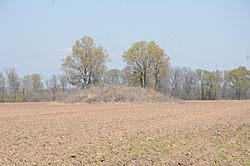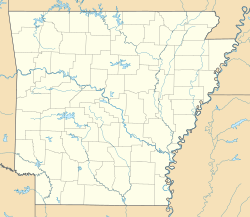Coy Site facts for kids
 |
|
| Location | England, Arkansas, Lonoke County, Arkansas, |
|---|---|
| Region | Lonoke County, Arkansas |
| Coordinates | 34°32′56.22″N 91°53′23.64″W / 34.5489500°N 91.8899000°W |
| History | |
| Founded | 730 CE |
| Abandoned | 1010 CE |
| Cultures | Plum Bayou culture |
| Site notes | |
| Excavation dates | 1883, 1988, 1994 |
| Archaeologists | Edward Palmer |
| Architecture | |
| Architectural styles | platform mounds, burial mound |
| Responsible body: private | |
The Coy Site (3 LN 20) is an important archaeological site located in Lonoke County, Arkansas. An archaeological site is a place where scientists study the past by digging up old objects. This site was once home to people of the Plum Bayou culture.
The Plum Bayou culture lived in this area between 650 and 1050 CE. This period is known as the Late Woodland period in North American history. The Coy Site itself was used by these people from about 700 to 1000 CE. In 1995, it was added to the National Register of Historic Places, which means it's a special place worth protecting.
Contents
What Was the Coy Site Like?
The Coy Site was once a complex settlement with several interesting features. It had four large earth structures called mounds. These mounds were built by people for different purposes.
Types of Mounds at Coy Site
Two main types of mounds were found at the Coy Site. There were flat-topped platform mounds. These were likely used for important buildings or ceremonies. There was also at least one burial mound, which was a place where people were buried.
The site also had large "midden areas." A midden is like an ancient trash heap. It's where people threw away their daily waste, like broken tools or food scraps. Archaeologists love middens because they contain many clues about how people lived.
Early Discoveries at Coy Site
The first known excavations at the Coy Site happened in 1883. An early archaeologist named Edward Palmer explored the area. He wrote down what he found, which helps us understand the site today.
Palmer described the two largest platform mounds. He said they were about 4 meters (13 feet) tall. He also noted a burial mound that was about 2.4 meters (8 feet) tall. There was also a smaller, low mound whose purpose was not clear.
What Remains Today?
Today, only the largest platform mound from the Coy Site still exists. The other mounds have been lost over time. Scientists returned to the site in 1988 and 1994 to study this remaining mound.
Their research helped confirm when the site was active. They found evidence that people lived there between 730 and 1010 CE. This matches what we know about the Plum Bayou culture.


